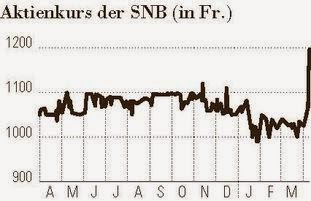The Swiss National Bank, for instance, was founded in 1907 to take upon itself the issuance of national bank notes, hitherto provided by private banks. According to Hübscher and Kuhn (pdf), efforts to establish a wholly government-owned central bank were defeated in an 1897 national referendum. Opponents of the plan drew up an alternative proposal for a privately owned bank the structure of which would, according to Bordo, “not allow for state socialism or the public control of credit policy.” One fifth of the new bank’s capital would be given to the private banks to compensate them for the loss of their power to issue notes.
Nowadays, SNB shares trade on the SIX Swiss Exchange. The original 100,000 shares are still outstanding, with 2,185 private shareholders owning about 37% of the float. Another 53% is owned by the cantonal governments and cantonal banks and the last 10% by other public institutions. The Swiss Federal council (Switzerland’s federal government) doesn’t own a single share, a contrast to most central banks which are 100% owned by their federal government. The largest private investor is Theo Siegert, who owns 5.95% of the float. The SNB provides all breakdowns here.
Though the shareholders of the five central banks may to some extent “own” their nation’s central bank, they don’t exercise the same degree of control over their company that regular shareholders do. Here are some of the drawbacks to owning central bank shares:
1. Capped dividends: The SNB’s dividend is capped at 6% of the company’s paid-up share capital. Because the SNB was originally capitalized with CHF 25 million, a large amount a hundred years ago but today a minuscule slice, aggregate dividend payments to all shareholders are limited to a mere CHF 1.5 million a year (around US$1.6 million), or CHF 10.50 per share. At today’s stock price of CHF 1115, the shares yield just 1% or so.
This is a stable dividend. The SNB has paid it going back to at least 1996 (the last annual report I could get my hands on). But unlike the typical common share, there is no chance of this dividend growing.
2. Profits siphoned away: Nor will the profits that are not distributed to shareholders stay with the Bank. The lion’s share of the SNB’s remaining profits go to the state. Specifically, two-thirds of earnings are paid to the cantonal governments, and another third to the Federal council. In 2011, for instance, the SNB earned CHF 4.9 billion. A tiny CHF 1.5 million sliver was paid to shareholders while the various governments received CHF 1 billion (the balance was held over as reserve for the next year).
Much like the SNB, the Bank of Japan (BOJ) pays a fixed dividend. The BOJ, established in 1882, trades on the JASDAQ for around ¥46,500 a share. The Bank is not permitted to pay more than 5% of its ¥100 million in paid-up capital to shareholders. As is the case with the SNB, this was a large amount back in 1942, the last time the BoJ was capitalized, but today its amounts to just ~$10 million. The upshot is that the BOJ can only provide shareholders a piddling ¥5 million in aggregate dividends a year, or ¥5 a share. This equates to just US$50,000 in aggregate dividend payments, or around 5 cents a share. Considering that total profits earned by the BOJ in 2011 amounted to ¥503 billion (around $5 billion), the shareholders are getting peanuts.
3. Minority position: Unlike the SNB, the Japanese federal government owns 55% of the Bank’s shares. This puts private shareholders at an even larger disadvantage since they must play second fiddle to a dominant shareholder at all shareholder meetings.
4. No residual claim: The Bank of Japan Act stipulates that should the Bank be dissolved, shareholders only get a return of initial paid-up capital. All residual assets belong to the national treasury. Thus shareholders get a mere ¥100 million (around $1 million) back in case of dissolution, or around ¥100 per share — far less than the current ¥46,500 a share. Genuine common shares would allow shareholders to getall residual assets.
According the the National Bank Act, SNB shareholders are also restricted in their ability to claim residual assets:
In case of a liquidation of the National Bank, the shareholders shall receive in cash the nominal value of their shares as well as reasonable interest for the period of time since the decision to liquidate the National Bank became effective. The shareholders shall not have any additional rights to the assets of the National Bank. Any remaining assets shall become the property of the new central bank.
This means that each SNB shareholder is entitled to CHF 250 a share upon dissolution, far less than the current CHF 1320.- per share price of today.
Week of study held in Rougemont, Canada in four languages end of August or in May followed by the Congress beg. of September
Free stay & meals, free pilgrimages
( St Joseph, N-D du Cap et St Anne )and free rooms for all our guests from countries outside of Canada.Money creation management by the Swiss National Bank.
9 oct. 2013 – Money creation management by the Swiss National Bank. … François deSiebenthal: Lettre à mon curé sur la “création monétaire .
François de Siebenthal: David against goliath, little swiss …
2 juin 2014 – With the full power of new money creation exclusively in the hands of theSwiss National Bank, the commercial banks would no longer have the …
Swiss national bank + 30 % Swiss central bank or swiss …
Il y a 34 minutes – Swiss central bank or swiss national bank, alias SNB, trades on the stock market. http://www.snb.ch/en/ Most people don’t realize that the central banks of Belgium, …
World population trend with total fertility rate below 2,2, i.e. near 1,5











Commentaires récents